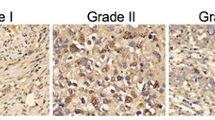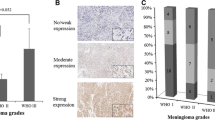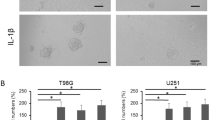Abstract
Background
Cervical cancer is a common gynecologic malignant tumor, but the critical factors affecting cervical cancer progression are still not well demonstrated. Mesencephalic astrocyte-derived neurotrophic factor (MANF) has been widely recognized as an anti-inflammatory factor to regulate macrophage polarization. In this study, the effect and mechanism of MANF on cervical cancer were preliminarily explored.
Methods and results
Kaplan–Meier curve was used to show the overall survival time of the involved cervical cancer patients with high and low MANF expression in cervical cancer tissues. MANF was highly expressed in peritumoral tissues of cervical carcinoma by using immunohistochemistry and western blot. MANF mRNA level was detected by using qRT-PCR. Dual-labeled immunofluorescence showed MANF was mainly expressed in macrophages of cervical peritumoral tissues. Moreover, MANF-silenced macrophages promoted HeLa and SiHa cells survival, migration, invasion and EMT via NF-κB signaling activation. The results of tumor formation in nude mice indicated MANF-silenced macrophages promoted cervical tumor formation in vivo.
Conclusion
Our study reveals an inhibitory role of MANF in cervical cancer progression, indicating MANF as a new and valuable therapeutic target for cervical cancer treatment.






Similar content being viewed by others
Data availability
This manuscript includes all data generated and analyzed in this study. More information is available from the corresponding author on request.
Abbreviations
- MANF:
-
Mesencephalic astrocyte-derived neurotrophic factor
- HPV:
-
Human papillomavirus
- EMT:
-
Esenchymal transition
- IFN-γ:
-
Interferon-γ
- LPS:
-
Lipopolysaccharide
- IL-4:
-
Interleukin-4
- TNF-α:
-
Tumor necrosis factor-α
- TGF-β:
-
Transforming growth factor-β
- ER:
-
Endoplasmic reticulum
References
Cohen PA, Jhingran A, Oaknin A, Denny L (2019) Cervical cancer. Lancet 393:169–182
Zhang L, Wang X, Lai M (2015) Modulation of epithelial-to-mesenchymal cancerous transition by natural products. Fitoterapia 106:247–255
Thiery JP, Acloque H, Huang RY, Nieto MA (2009) Epithelial-mesenchymal transitions in development and disease. Cell 139:871–890
Mani SA, Guo W, Liao MJ, Eaton EN, Ayyanan A, Zhou AY et al (2008) The epithelial-mesenchymal transition generates cells with properties of stem cells. Cell 133:704–715
Singh A, Settleman J (2010) EMT, cancer stem cells and drug resistance: an emerging axis of evil in the war on cancer. Oncogene 29:4741–4751
Shibue T, Weinberg RA (2017) EMT, CSCs, and drug resistance: the mechanistic link and clinical implications. Nat Rev Clin Oncol 14:611–629
Lambert AW, Pattabiraman DR, Weinberg RA (2017) Emerging biological principles of metastasis. Cell 168:670–691
Rojas-Puentes L, Cardona AF, Carranza H, Vargas C, Jaramillo LF, Zea D et al (2016) Epithelial-mesenchymal transition, proliferation, and angiogenesis in locally advanced cervical cancer treated with chemoradiotherapy. Cancer Med 5:1989–1999
Qureshi R, Arora H, Rizvi MA (2015) EMT in cervical cancer: its role in tumour progression and response to therapy. Cancer Lett 356:321–331
Glass CK, Natoli G (2016) Molecular control of activation and priming in macrophages. Nat Immunol 17:26–33
Gundra UM, Girgis NM, Ruckerl D, Jenkins S, Ward LN, Kurtz ZD et al (2014) Alternatively activated macrophages derived from monocytes and tissue macrophages are phenotypically and functionally distinct. Blood 123:e110-122
Ivanova EA, Orekhov AN (2016) Monocyte activation in immunopathology: cellular test for development of diagnostics and therapy. J Immunol Res 2016:4789279
Alvarado-Diaz CP, Nunez MT, Devoto L, Gonzalez-Ramos R (2015) Iron overload-modulated nuclear factor kappa-B activation in human endometrial stromal cells as a mechanism postulated in endometriosis pathogenesis. Fertil Steril 103:439–447
Gupta S, Maitra A (2016) EMT: matter of life or death? Cell 164:840–842
Yu YQ, Liu LC, Wang FC, Liang Y, Cha DQ, Zhang JJ et al (2010) Induction profile of MANF/ARMET by cerebral ischemia and its implication for neuron protection. J Cereb Blood Flow Metab 30:79–91
Chen YC, Sundvik M, Rozov S, Priyadarshini M, Panula P (2012) MANF regulates dopaminergic neuron development in larval zebrafish. Dev Biol 370:237–249
Yang W, Shen Y, Chen Y, Chen L, Wang L, Wang H et al (2014) Mesencephalic astrocyte-derived neurotrophic factor prevents neuron loss via inhibiting ischemia-induced apoptosis. J Neurol Sci 344:129–138
Lindholm P, Saarma M (2010) Novel CDNF/MANF family of neurotrophic factors. Dev Neurobiol 70:360–371
Apostolou A, Shen Y, Liang Y, Luo J, Fang S (2008) Armet, a UPR-upregulated protein, inhibits cell proliferation and ER stress-induced cell death. Exp Cell Res 314:2454–2467
Wang C, Bao Q, Hou C, Sun M, Song X, Cao S et al (2021) Mono-macrophage-derived MANF alleviates bacterial myocarditis by Inhibiting NF-kappaB activation and myocardial inflammation. Inflammation 44:1916–1926
Hou C, Mei Q, Song X, Bao Q, Li X, Wang D et al (2021) Mono-macrophage-derived MANF protects against lipopolysaccharide-induced acute kidney injury via inhibiting inflammation and renal M1 macrophages. Inflammation 44:693–703
Sun T, Zhang X, Hou C, Yu S, Zhang Y, Yu Z et al (2022) Cold plasma irradiation attenuates atopic dermatitis via enhancing hif-1alpha-induced manf transcription expression. Front Immunol 13:941219
Chen L, Feng L, Wang X, Du J, Chen Y, Yang W et al (2015) Mesencephalic astrocyte-derived neurotrophic factor is involved in inflammation by negatively regulating the NF-kappaB pathway. Sci Rep 5:8133
Neves J, Zhu J, Sousa-Victor P, Konjikusic M, Riley R, Chew S et al (2016) Immune modulation by MANF promotes tissue repair and regenerative success in the retina. Science 353:aaf3646
Wang C, Yu S, Bao Q, Qiang W, Wu C, Zhang C et al (2020) Circulating mesencephalic astrocyte-derived neurotrophic factor negatively correlates with atrial apoptosis in human chronic atrial fibrillation. J Cardiovasc Pharmacol 75:141–147
Shen SN, Wang LF, Jia YF, Hao YQ, Zhang L, Wang H (2013) Upregulation of microRNA-224 is associated with aggressive progression and poor prognosis in human cervical cancer. Diagn Pathol 8:69
Pecorelli S (2009) Revised FIGO staging for carcinoma of the vulva, cervix, and endometrium. Int J Gynaecol Obstet 105:103–104
Hou C, Wang D, Li X, He Y, Wei C, Jiang R et al (2019) MANF regulates splenic macrophage differentiation in mice. Immunol Lett 212:37–45
Helm O, Held-Feindt J, Schafer H, Sebens S (2014) M1 and M2: there is no “good” and “bad”—how macrophages promote malignancy-associated features in tumorigenesis. Oncoimmunology 3:e946818
Visan I (2022) Inflammatory macrophages. Nat Immunol 23:988
Coussens LM, Werb Z (2002) Inflammation and cancer. Nature 420:860–867
Pires BRB, Mencalha AL, Ferreira GM, de Souza WF, Morgado-Díaz JA, Maia AM et al (2017) NF-kappaB Is involved in the regulation of EMT genes in breast. Cancer Cells 12:e0169622
Kalluri R (2009) EMT: when epithelial cells decide to become mesenchymal-like cells. J Clin Invest 119:1417–1419
Lopez-Novoa JM, Nieto MA (2009) Inflammation and EMT: an alliance towards organ fibrosis and cancer progression. EMBO Mol Med 1:303–314
Zhang T, Ma C, Zhang Z, Zhang H, Hu H (2020) NF-kappaB signaling in inflammation and cancer. MedComm 2021(2):618–653
Dong W, Sun S, Cao X, Cui Y, Chen A, Li X et al (2017) Exposure to TNF-alpha combined with TGF-beta induces carcinogenesis in vitro via NF-kappaB/Twist axis. Oncol Rep 37:1873–1882
Song R, Song H, Liang Y, Yin D, Zhang H, Zheng T et al (2014) Reciprocal activation between ATPase inhibitory factor 1 and NF-kappaB drives hepatocellular carcinoma angiogenesis and metastasis. Hepatology 60:1659–1673
Liu S, Shi L, Wang Y, Ye D, Ju H, Ma H et al (2018) Stabilization of slug by NF-kappab is essential for TNF-alpha -induced migration and epithelial-mesenchymal transition in head and neck squamous cell carcinoma cells. Cell Physiol Biochem 47:567–578
Nieto MA, Huang RY, Jackson RA, Thiery JP (2016) Emt: 2016. Cell 166:21–45
Casas E, Kim J, Bendesky A, Ohno-Machado L, Wolfe CJ, Yang J (2011) Snail2 is an essential mediator of Twist1-induced epithelial mesenchymal transition and metastasis. Cancer Res 71:245–254
Sleeman JP, Thiery JP (2011) SnapShot: The epithelial-mesenchymal transition. Cell 145(162):e161
Farzanehpour M, Faghihloo E, Salimi V, Jalilvand S, Akhavan S, Muhammadnejad A et al (2020) Comparison of snail1, ZEB1, E-cadherin expression levels in HPV-induced cervical cancer. Iran J Public Health 49:2179–2188
Liu J, Wu Z, Han D, Wei C, Liang Y, Jiang T et al (2020) Mesencephalic astrocyte-derived neurotrophic factor inhibits liver cancer through small ubiquitin-related modifier (sumo)ylation-related suppression of nf-kappab/snail signaling pathway and epithelial-mesenchymal transition. Hepatology 71:1262–1278
Hou C, Wang D, Zhao M, Ballar P, Zhang X, Mei Q et al (2023) MANF brakes TLR4 signaling by competitively binding S100A8 with S100A9 to regulate macrophage phenotypes in hepatic fibrosis. Acta Pharm Sin B 13:4234–4252
Cho U, Kim B, Kim S, Han Y, Song YS (2018) Pro-inflammatory M1 macrophage enhances metastatic potential of ovarian cancer cells through NF-kappaB activation. Mol Carcinog 57:235–242
Luo Y, Mo D, Guo H, Ye C, Chen B, Zhu H et al (2022) NF-kappaB inactivation attenuates the M1 macrophage polarization in experimental necrotizing enterocolitis by glutaredoxin-1 deficiency. Cell Biol Int 46:1886–1899
Acknowledgements
Not applicable.
Funding
The study was supported by the Non-profit Central Research Institute Fund of Chinese Academy of Medical Sciences (Grant number: 2019PT310002) to Yunxia Cao, and the Research Fund of Anhui Institute of Translational Medicine (Grant number: ZHYX2020A001) to Yunxia Cao.
Author information
Authors and Affiliations
Contributions
Miaomiao Huang: Conceptualization, Investigation, Supervision, Methodology, Writing-original draft. Jingjing hu: Investigation, Methodology. Yueran Chen: Investigation, Methodology, Formal analysis. Yingying Xun: Methodology. Xinru Zhang: Methodology, Resources. Yunxia Cao: Conceptualization, Investigation, Supervision, Methodology, Funding acquisition.
Corresponding author
Ethics declarations
Conflict of interest
The authors declare that they have no potential conflicts of interest.
Ethical approval
The Ethical Committee of Anhui Medical University approved this research.
Research involving human and animal rights
All the experiments related to human tissues were conducted in accordance with Helsinki criteria and were performed by the Ethics Committee of First Affiliated Hospital of Anhui Medical University (Approval number: PJ2021-15-28). All patients participating in the study were given informed consent. All animals received humane care according to the criteria outlined in the Guide for the Care and Use of Laboratory Animals prepared by the National Academy of Sciences and published by the National Institutes of Health.
Consent for publication
All authors have given consents for publication.
Additional information
Publisher's Note
Springer Nature remains neutral with regard to jurisdictional claims in published maps and institutional affiliations.
Supplementary Information
Below is the link to the electronic supplementary material.
11033_2024_9602_MOESM1_ESM.pdf
Supplementary file1 Figure S1. MANF knockdown in THP-1 cells promoted pro-inflammatory cytokines production and secretion. THP-1 cells were treated with 100 ng/mL phorbol myristate acetate (PMA) for 48 hours following LPS (100 ng/ml) and IFN-γ (20 ng/ml) stimulation for 24 hours to induce M1 macrophage polarization. (A) The protein and (B) mRNA levels of IL-1β, IL-6, CXCL10 and TNF-α were detected by using western blot and qRT-PCR respectively. GAPDH serves as control for normalization. The relative protein levels were calculated. (C) The medium IL-1β, IL-6, CXCL10 and TNF-α levels from THP-1-derived macrophages were detected by using ELISA. THP-1 cells were transfected with siRNA-Con and siRNA-MANF following LPS (100 ng/ml) and IFN-γ (20 ng/ml) stimulation for 24 hours. (D) MANF protein and (E) mRNA levels in THP-1-derived macrophages were decreased after transfection with siRNA-MANF. (F) The protein and (G) mRNA levels of IL-1β, IL-6, CXCL10 and TNF-α in THP-1-derived macrophages were increased after transfection with siRNA-MANF. GAPDH serves as control for normalization. The relative protein levels were calculated. (H) The medium IL-1β, IL-6, CXCL10 and TNF-α levels from THP-1-derived macrophages after transfection with siRNA-MANF were detected by using ELISA. Data are expressed as mean±SEM. **p<0.01, ***p<0.001, n=6. (PDF 207 kb)
11033_2024_9602_MOESM2_ESM.pdf
Supplementary file2 Figure S2. MANF affected EMT and relevant transcription factors of HeLa and SiHa cells. (A) HeLa and SiHa cells were co-cultured in an indirect contact with Control or MANF-silenced macrophages in serum-free medium. The protein levels of Slug, ZEB1 and Twist in HeLa and SiHa cells were detected by using western blot. (B) 5 μg/mL recombinant human MANF protein was added to treat HeLa and SiHa cells. The E-Cadherin and Vimentin protein levels were detected by using western blot. GAPDH serves as control for normalization. (PDF 83 kb)
11033_2024_9602_MOESM3_ESM.pdf
Supplementary file3 Figure S3. MANF knockdown exerted no effect on macrophage proliferation. PCNA level was examined by using western blot in Control or MANF-silenced macrophages. GAPDH serves as control for normalization. (PDF 43 kb)
Rights and permissions
Springer Nature or its licensor (e.g. a society or other partner) holds exclusive rights to this article under a publishing agreement with the author(s) or other rightsholder(s); author self-archiving of the accepted manuscript version of this article is solely governed by the terms of such publishing agreement and applicable law.
About this article
Cite this article
Huang, M., Hu, J., Chen, Y. et al. Mesencephalic astrocyte-derived neurotrophic factor inhibits cervical cancer progression via regulating macrophage phenotype. Mol Biol Rep 51, 654 (2024). https://doi.org/10.1007/s11033-024-09602-6
Received:
Accepted:
Published:
DOI: https://doi.org/10.1007/s11033-024-09602-6




